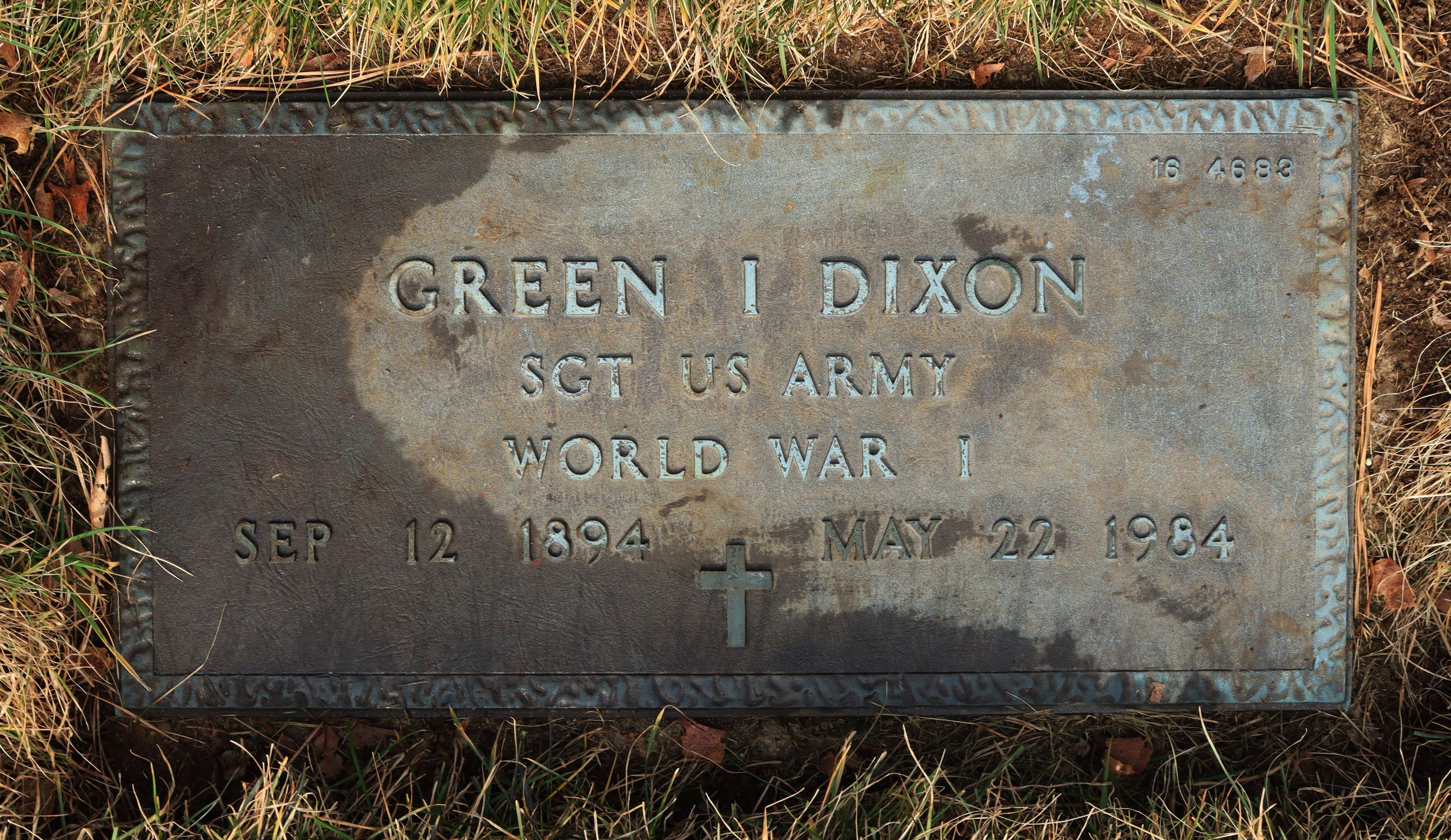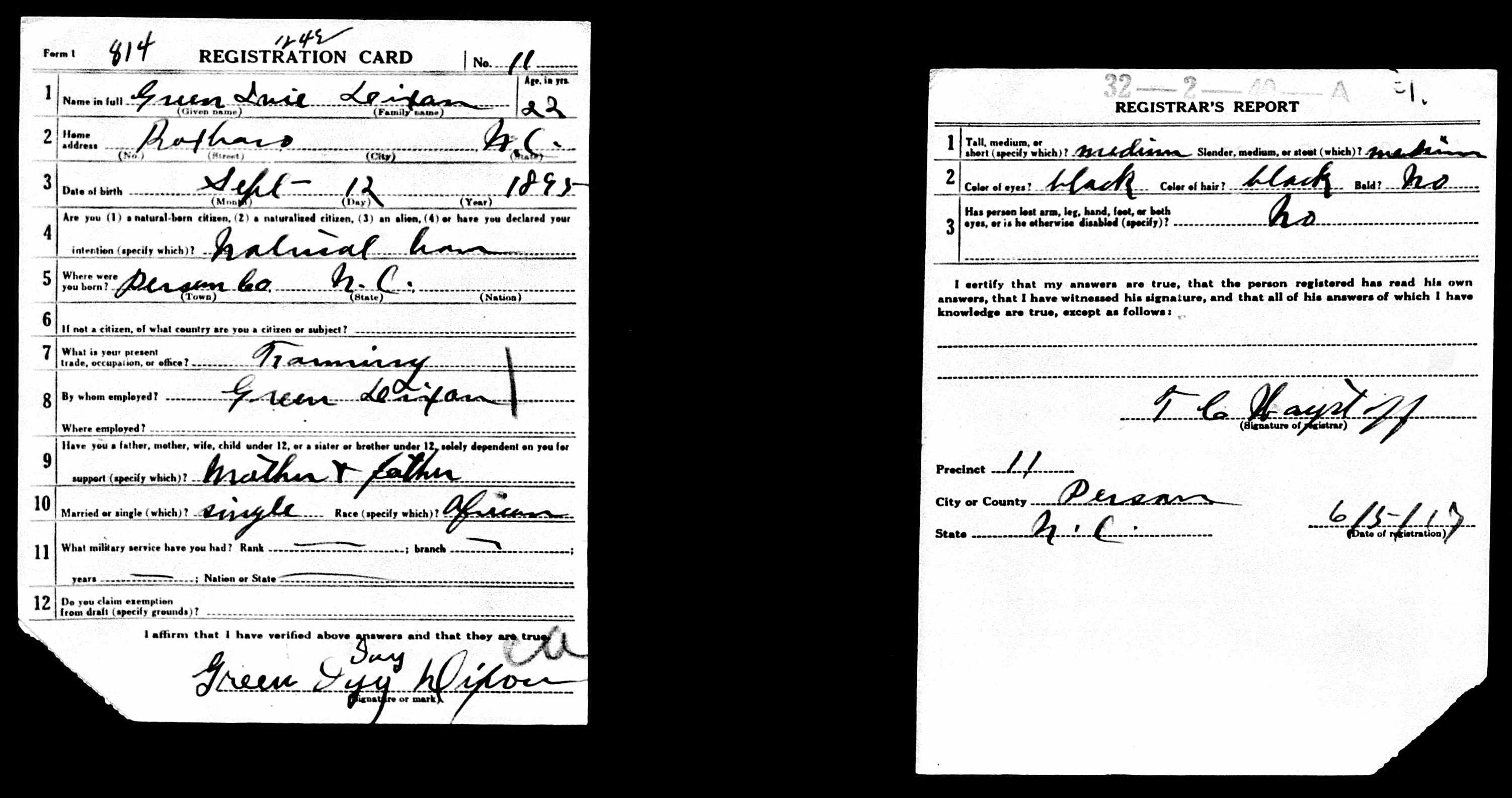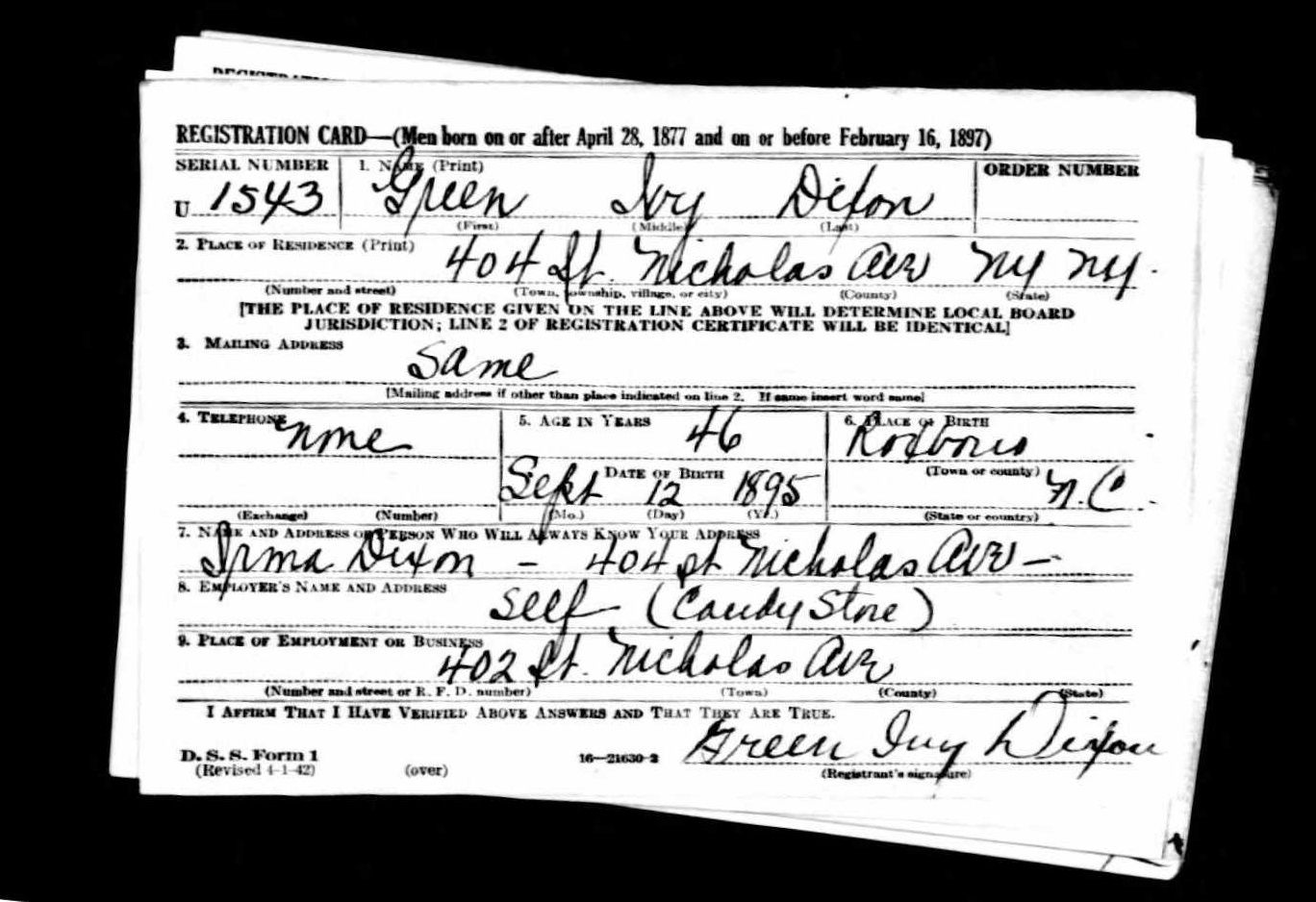He was the father of American Actor Ivan Dixon, who worked from the 1950s to 1990s and was most known for his role as 'Sgt. James 'Kinch' Kinchloe' in the popular 1960's CBS ensemble cast comedy series "Hogan's Heroes" which ran from 1965 to 1970 and is still seen in syndication.
According to Green's World War I draft registration card, at that time he was farming in his native Person County, NC. He enlisted on 30 Nov 1917 and was discharged on 27 Feb 1919, after returning from France on the troopship SS Leviathan. The 371st Infantry Regiment was a segregated black regiment, nominally a part of the 93rd Division, that served in World War I under French Army command, and also in World War II in the Italian Campaign as part of the 92nd Infantry Division (Colored). In both wars the unit had primarily black enlisted men and white officers. The regiment moved to France in April 1918. On arrival in France, the unit was transferred into the French command, so most of its decorations are French rather than American. The 371st Infantry was seconded, along with the 372nd Infantry Regiment, to the 157th Infantry Division of the French Army, called the "Red Hand Division". Under the command of General Mariano Goybet, the division was in need of reinforcements.
Emmet J. Scott's Official History of the American Negro in the World War provides a summary of when the men were fighting with gallantry on the Western Front in the Champagne region of France for victory:
"The 371st remained in line for over three months, holding first the Avocourt and later the Verrières subsectors (northwest of Verdun). The regiment, with its division, was then taken out of line and thrown into the great September offensive in the Champagne. It took Côte 188 (Hill 188), Bussy Ferme, Ardeuil, Montfauxelles, and Trieres Ferme near Monthois, and captured a number of prisoners, 47 machine guns, 8 trench engines (possibly minenwerfers), 3 field pieces (77 mm guns), a munition depot, a number of railroad cars, and enormous quantities of lumber, hay, and other supplies. It shot down three German airplanes by rifle and machine-gun fire during the advance."
"During the fighting between September 28 and October 6, 1918, its losses—which were mostly in the first three days—were 1,065 out of 2,384 actually engaged (total killed, wounded, prisoners, and missing). ("American Armies" gives 882 casualties for the same period, but only includes casualties "while in line".) The regiment was the apex of the attacking salient in this great battle. The percentage of both dead and wounded among the officers was rather greater than among the enlisted men. Realizing their great responsibilities, the wounded officers continued to lead their men until they dropped from exhaustion and lack of blood. The men were devoted to their, leaders and as a result stood up against—a most grueling fire, bringing the regiment its well deserved fame."
Following his discharge, Green returned to his family's farm in Allen, Person County, NC to work on the farm along with his older brother, Alvis, who also served in the war, and his three younger sisters, Lucille, Winnie and Mary. Sometime after his father's death in 1923, Green moved to New York City. Per the 1930 Census he was working as an elevator operator and living in New York City with his widowed mother, Winnie L. Dixon and younger sister, Winnie E. Dixon, who worked as a hairstylist. On September 30, 1930 Green married Irma L. McAlister in Manhattan, where son Ivan Dixon, the future actor, was born the following year. Later, Green and Irma owned a candy store at 404 St. Nicholas Ave. in New York City. Irma died in 1987 at age 80 and Green died in 1984 at the age of 89.
Military Information: SG T, US ARMY
He was the father of American Actor Ivan Dixon, who worked from the 1950s to 1990s and was most known for his role as 'Sgt. James 'Kinch' Kinchloe' in the popular 1960's CBS ensemble cast comedy series "Hogan's Heroes" which ran from 1965 to 1970 and is still seen in syndication.
According to Green's World War I draft registration card, at that time he was farming in his native Person County, NC. He enlisted on 30 Nov 1917 and was discharged on 27 Feb 1919, after returning from France on the troopship SS Leviathan. The 371st Infantry Regiment was a segregated black regiment, nominally a part of the 93rd Division, that served in World War I under French Army command, and also in World War II in the Italian Campaign as part of the 92nd Infantry Division (Colored). In both wars the unit had primarily black enlisted men and white officers. The regiment moved to France in April 1918. On arrival in France, the unit was transferred into the French command, so most of its decorations are French rather than American. The 371st Infantry was seconded, along with the 372nd Infantry Regiment, to the 157th Infantry Division of the French Army, called the "Red Hand Division". Under the command of General Mariano Goybet, the division was in need of reinforcements.
Emmet J. Scott's Official History of the American Negro in the World War provides a summary of when the men were fighting with gallantry on the Western Front in the Champagne region of France for victory:
"The 371st remained in line for over three months, holding first the Avocourt and later the Verrières subsectors (northwest of Verdun). The regiment, with its division, was then taken out of line and thrown into the great September offensive in the Champagne. It took Côte 188 (Hill 188), Bussy Ferme, Ardeuil, Montfauxelles, and Trieres Ferme near Monthois, and captured a number of prisoners, 47 machine guns, 8 trench engines (possibly minenwerfers), 3 field pieces (77 mm guns), a munition depot, a number of railroad cars, and enormous quantities of lumber, hay, and other supplies. It shot down three German airplanes by rifle and machine-gun fire during the advance."
"During the fighting between September 28 and October 6, 1918, its losses—which were mostly in the first three days—were 1,065 out of 2,384 actually engaged (total killed, wounded, prisoners, and missing). ("American Armies" gives 882 casualties for the same period, but only includes casualties "while in line".) The regiment was the apex of the attacking salient in this great battle. The percentage of both dead and wounded among the officers was rather greater than among the enlisted men. Realizing their great responsibilities, the wounded officers continued to lead their men until they dropped from exhaustion and lack of blood. The men were devoted to their, leaders and as a result stood up against—a most grueling fire, bringing the regiment its well deserved fame."
Following his discharge, Green returned to his family's farm in Allen, Person County, NC to work on the farm along with his older brother, Alvis, who also served in the war, and his three younger sisters, Lucille, Winnie and Mary. Sometime after his father's death in 1923, Green moved to New York City. Per the 1930 Census he was working as an elevator operator and living in New York City with his widowed mother, Winnie L. Dixon and younger sister, Winnie E. Dixon, who worked as a hairstylist. On September 30, 1930 Green married Irma L. McAlister in Manhattan, where son Ivan Dixon, the future actor, was born the following year. Later, Green and Irma owned a candy store at 404 St. Nicholas Ave. in New York City. Irma died in 1987 at age 80 and Green died in 1984 at the age of 89.
Military Information: SG T, US ARMY
Family Members
Sponsored by Ancestry
Advertisement
Records on Ancestry
Advertisement









